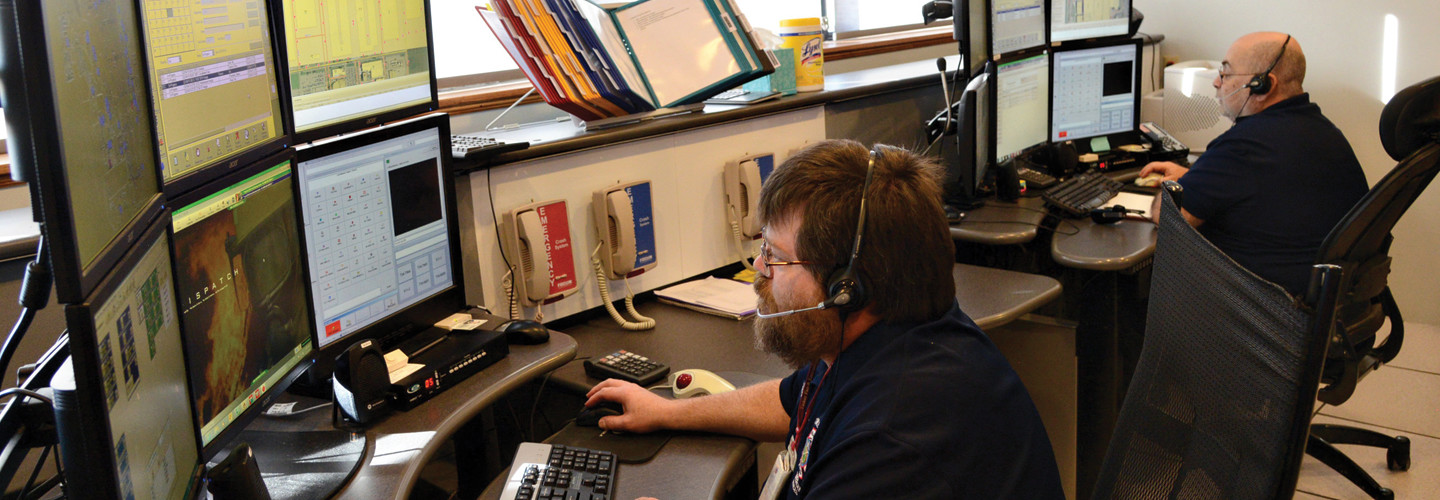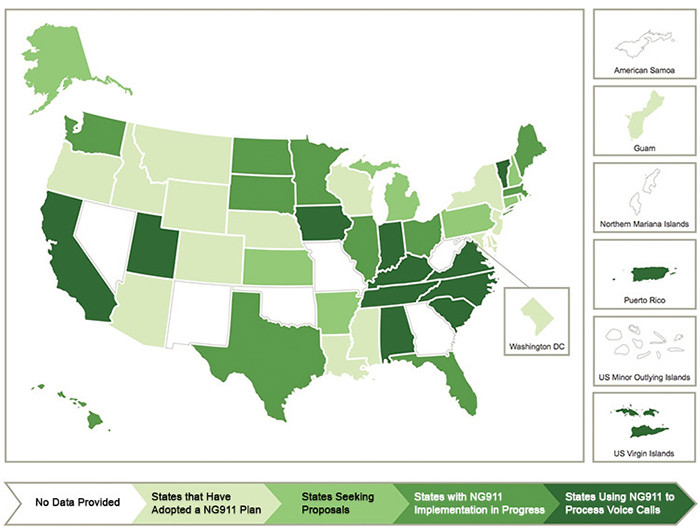The combined data, from the National 911 Profile Database and NENA’s NG911 database, provides a snapshot of each state and territory’s progress toward fully utilizing NG911 infrastructure and capabilities. Source: 911.gov
Pat Lustig, NG911 project manager for the state of Oregon, notes that NG911 requires different protocols than legacy 911 systems. He notes that legacy 911 uses multifrequency protocols. All NG911 calls need to use session-initiated protocols, or SIP, which can take multimedia information and deliver it to an aggregation point so that it can be sent to a 911 call center.
NENA lays out 11 factors that PSAPs need to meet to consider themselves fully capable of delivering NG911 via an all IP-based telephony system with a corresponding IP-based Emergency Services IP Network, or ESInet.
Among them are that all calls entering the ESInet are SIP-based, and that gateways, if needed, are outside of or on the edge of the ESInet. Additionally, DSL providers, fiber network providers, wireless carriers and other access providers need to install, provision and operate some kind of location function for their networks.
NENA notes that location functions are “critical for 911 calls originating on an IP network because it provides a 911 valid location to IP clients that bundle their location in the SIP signaling to the ESInet.” All calls entering the ESInet will normally have location (which might be coarse, like the cell site or sector) in the signaling with the call.
911 authorities also need to transition from the tabular address and location systems to geospatial, GIS-based Location Validation Function and Emergency Call Routing Function.
What Are the Benefits of NG911 Technology?
Although upgrading to NG911 can be a costly, time-intensive process (Abley estimates six to 18 months on average for a deployment), its proponents point to numerous benefits of the switch.
NG911 will deliver better and more accurate location information to PSAPs, NENA’s Heinze says.
Additionally, Morison notes, NG911 enables “the opportunity to collect more detailed information, in multiple media, from the public about situations taking place in their communities.”
NG911 technology enables PSAPs to receive text messages, which is important, especially in situations where a crime victim or witness cannot easily carry on a voice conversation, Morison notes.
“But text is just the tip of the NG911 iceberg,” he says.
The true power and potential of NG911 rests in the ability for PSAPs to collect photos and especially videos of unfolding incidents — fires, a car crash or a potential act of violence — so that the information can be relayed to first responders.
When the public can supply “detailed, highly visual information about these types of incidents” to 911 call centers, which can then relay that information to first responders, the police officers, firefighters and EMS workers will be “in a much better position to respond safely and effectively to that emergency,” Morison notes.
NG911 will also allow individual PSAPs to connect via IP-based broadband networks, which will “dramatically improve their ability to manage 911calls, especially during natural disasters or other major critical incidents,” according to Morison.
If one PSAP is overloaded with calls or goes down entirely for some reason during a disaster, calls that would normally go to that center could be automatically routed to another PSAP. The state of Vermont already has this type of IP network among its eight 911 centers, Morison notes, which “proved to be crucial in 2011 when tropical storm Irene caused major flooding in the state and completely knocked out one of its busiest” PSAPs. As a result of NG911 infrastructure, calls were rerouted and no calls were missed, Morison says.
Frank Kuchta, state 911 program manager in Oregon, notes in the case of a hurricane threatening a coastal area, NG911 can enable PSAPs to reroute calls before the storm hits to 911 call centers further inland.
Key NG911 Vendors to Consider
There are new players coming into the NG911 technology market, Oregon’s Lustig notes, for everything from call taker equipment to 911 workstations and customer-premises equipment. However, he says, many legacy vendors have transitioned to IP networks.
Kuchta says there are new vendors in supplemental services, such as telematics and improved location services. However, core NG911 services are still provided by large carriers, such as CenturyLink and Verizon.
Indiana elected to have two vendors operate redundant ESInets and provide Next Generation Core Services across the state, according to Reuter.
“The deployment methodology is for each of the vendors to operate their respective ESInets in their service areas while maintaining the ability to provide NG911 services statewide to all 122 PSAPs,” he says. “The vendors, AT&T and INdigital, will connect their ESInets at the core and serve the entire state. In the event there is a 911 outage by one of the vendors, the other will be able to provide continuous service.”
The National 911 Project has developed NG911 procurement guidance for PSAP managers to follow as they begin to upgrade legacy systems.
NG911 Implementation Best Practices
Implementation on NG911 can be challenging in the IP-based environment, Morison notes.
“And while individual jurisdictions can certainly go it alone, I think jurisdictions will probably achieve better results when they work together on implementation,” he says. “Vermont is a good example of that. So is the consortium of 13 largely rural counties in southern Illinois that came together in 2015 to create a regional IP-based network connecting 17 ECCs. And the states can and should be playing a major role in the planning and funding of NG911 systems.”
Reuter notes that, in Indiana’s experience, the best deployment for an ESInet and NGCS is through a statewide program. “This design allows all PSAPs to provide the same level of service in all 92 counties,” he says. “A statewide deployment with single-entity oversight allows the state to provide for and purchase services that are more consistent and at an economical advantage.”










